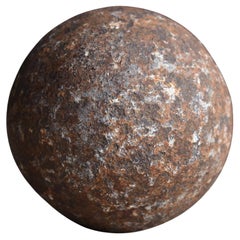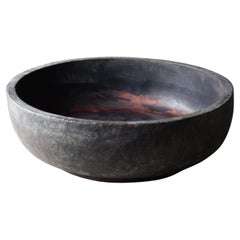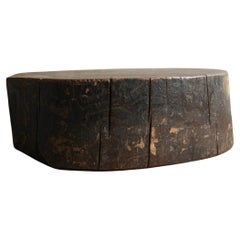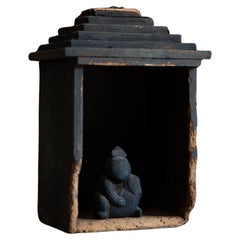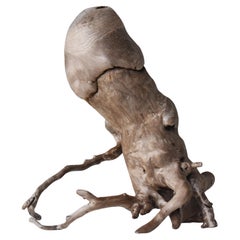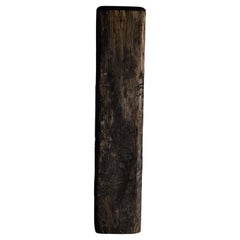Japan - Antiquities
to
16
186
885
424
172
13
1
2
1
1
16
43
113
14
82
10
1
1
1
1
1
131
31
16
12
12
173
169
165
3
2
186
183
183
10
Item Ships From: Japan
Japanese Antique Artillery Shell 1900s-1920s / Iron Ball Object Wabisabi
Located in Chōsei District Nagara, JP
This is an old Japanese artillery shell.
From its appearance, it is assumed that it is an iron shell for artillery.
Considering the size, shape, and rusty condition of this iron ball...
Category
1910s Japanese Showa Vintage Japan - Antiquities
Materials
Iron
Japanese Antique Huge Wooden Bowl 1906s / Primitive Object Wabisabi Mingei
Located in Chōsei District Nagara, JP
This is a huge old Japanese lacquer wood bowl.
It was manufactured in 1906 (Meiji period), and its age can be read from the writing on the bottom. The material used is cedar wood, ma...
Category
Early 1900s Japanese Meiji Antique Japan - Antiquities
Materials
Cedar, Lacquer
Japanese antique wooden work board / 20th century / small display stand
Located in Sammu-shi, Chiba
This is an old Japanese wooden workbench made from zelkova wood (keyaki), known for its hardness and beautiful grain. The thick cross-sectional shape clearly reveals the concentric g...
Category
20th Century Japanese Taisho Japan - Antiquities
Materials
Wood
Antique Japanese Zushi, wabi sabi miniature shrine w/ Ebisu figurine mingei
Located in 常陸大宮市, JP
Antique wooden Zushi (miniature shrine, the "house of the Gods") with mini wooden figurine of Ebisu - from Tohoku area., Japan.
Manufactured circa 1860s - 1900s (late Edo to Meiji pe...
Category
Late 19th Century Japanese Primitive Antique Japan - Antiquities
Materials
Wood
Japanese Antique Natural Wood Penis 1860s-1920s / Figurine Object Wabisabi
Located in Chōsei District Nagara, JP
This is a phallic statue made of natural wood produced in Japan.
It is estimated to have been created during the Meiji and Taisho periods (1860s-1920s), and is made of richly texture...
Category
Early 20th Century Japanese Meiji Japan - Antiquities
Materials
Pine
Japanese old wood stand / Exhibition stand wabi-sabi / primitive wood stand /
Located in Sammu-shi, Chiba
This display stand is made by combining old wooden sleepers with a newly made tabletop.
The top of the display stand is finished with cashew paint, like lacquer, and has a jet blac...
Category
Mid-20th Century Japanese Primitive Japan - Antiquities
Materials
Wood
Antique Japanese Mino straw cape made of rice straws, mingei wabi sabi art piece
Located in 常陸大宮市, JP
Antique "Mino", also called "Bandori" Straw cape made of rice straws - From Tohoku area, Japan.
Dear customer - feel free to inquire me for the shipping fee quote.
The shipping fee ...
Category
Late 19th Century Japanese Taisho Antique Japan - Antiquities
Materials
Cotton, Linen, Straw
Old Japanese black maneki-neko object / 20th century / lucky ornament
Located in Sammu-shi, Chiba
Here is a Japanese "Maneki Neko" (beckoning cat) figurine from the Showa era. It is made from either clay or plaster and features a simple yet impactful design. On the back, you can ...
Category
20th Century Japanese Showa Japan - Antiquities
Materials
Plaster, Clay
Japanese antique pottery fragments/12th to 13th century/Flower vase
Located in Sammu-shi, Chiba
Tokoname ware is a historic kiln in Japan, where pottery has been made since before the Common Era, and a kiln was established in the 5th century. This kiln is located in Aichi Prefe...
Category
15th Century and Earlier Japanese Other Antique Japan - Antiquities
Materials
Pottery
Japanese Old Shell Casing 1930s-1940s / Iron Object Flower Vase Wabi Sabi
Located in Chōsei District Nagara, JP
This is the warhead part (shell) of an old Japanese shell. Functional parts such as the internal explosive and fuse have already been lost, and we present this as a safe relic that h...
Category
1930s Japanese Showa Vintage Japan - Antiquities
Materials
Iron
Japanese antique wooden octagonal display stand/bonsai stand/flower stand
Located in Sammu-shi, Chiba
This is an old wooden flower stand from Japan.
It is believed to be from around the 20th century.
Originally, it may have been used in temples to hold offerings of flowers, but this ...
Category
20th Century Japanese Taisho Japan - Antiquities
Materials
Wood
Korean antique cup-shaped earthenware/excavated earthenware/hard earthenware
Located in Sammu-shi, Chiba
This is a very old cup-shaped earthenware from Korea.
It was made in a country called "Kaya" located at the southern tip of the Korean peninsula.
This is fired at a kiln temperature ...
Category
15th Century and Earlier South Korean Other Antique Japan - Antiquities
Materials
Pottery
Japanese Antique Wood Low Table , Primitive Low Table , Wabi Sabi
Located in Katori-Shi, 12
This is an antique low table from the Taisho period.
The table top is made of five pieces of Shurizakura wood with beautiful grain, and its rich expression captivates the viewer. In...
Category
Early 20th Century Japanese Taisho Japan - Antiquities
Materials
Wood
Japanese Antique flower stand, Wabi-Sabi, Japandi
Located in Katori-Shi, 12
It has a soft, rounded top and potter's wheel legs with a dignified appearance.
This flower stand was made in the Taisho period.
The lines that taper slightly towards the end of the ...
Category
Early 20th Century Japanese Taisho Japan - Antiquities
Materials
Wood
Japanese Antique Wooden Board , Wall Decoration Abstract Art , Wabi-Sabi
Located in Katori-Shi, 12
This wooden board was made in the Taisho era.
The dense and beautiful grain of the wood, unique to time-honored zelkova, is eye-catching. The color that has deepened over the years,...
Category
Early 20th Century Japanese Taisho Japan - Antiquities
Materials
Wood
Japanese Antique Wooden Brazier/Hibachi Brazier/1868-1912s Wabi-Sabi
Located in Iwate-gun Shizukuishi-cho, Iwate Prefecture
This is an old Japanese brazier.
It is made of zelkova wood and is thought to date back to the Meiji period.
It features the strong grain of zelkova...
Category
Late 19th Century Japanese Primitive Antique Japan - Antiquities
Materials
Copper
Japanese Antique Exhibition Stand / Sword Case / 1800-1868s / Wabi-sabi
Located in Iwate-gun Shizukuishi-cho, Iwate Prefecture
This is an old drawer for storing Japanese swords originally called "Katanatansu".
It is thought to be from around the Edo period.
Cedar is used for the material, and a large numbe...
Category
Mid-19th Century Japanese Edo Antique Japan - Antiquities
Materials
Wood, Paper, Cedar
Japanese Antique Black Lantern Box /1896s Objet d'art Wabi-sabi
Located in Iwate-gun Shizukuishi-cho, Iwate Prefecture
This is a lantern box from the old days of Japan.
The box is pasted with Japanese paper and painted with black lacquer.
There is a description of "Meiji 29" on the back.
The lantern box is a box that stores folded lanterns...
Category
1890s Japanese Meiji Antique Japan - Antiquities
Materials
Wood, Cedar, Paper
$320 Sale Price
46% Off
Japanese Antique Glass Low Table, Wabi Sabi
Located in Katori-Shi, 12
This antique low table was made in the Taisho era.
The tabletop is made of a single piece of high-quality zelkova wood. The legs are lathe-turned.
It is unified with a ginkgo surfa...
Category
Early 20th Century Japanese Taisho Japan - Antiquities
Materials
Wood, Glass
Japanese Antique Chests of Drawers 1860s-1900s /Tansu, Wabi-Sabi
Located in Katori-Shi, 12
This small drawer was produced in the Taisho period.
This chest is made of sturdy cedar with a lacquer finish, with a base panel made of lightweight paulownia wood and an iron handl...
Category
Early 20th Century Japanese Taisho Japan - Antiquities
Materials
Wood
Japanese Antique Stone Display Stand / Objet / Before 1868s / Wabi-Sabi Mingei
Located in Iwate-gun Shizukuishi-cho, Iwate Prefecture
This is an old stone stand in Japan.
I don't know the details if it was used as a stand for beating straw, but it seems to be before the end of the Edo period.
The round silhouette...
Category
Mid-19th Century Japanese Rustic Antique Japan - Antiquities
Materials
Stone
D2 Japanese Antiques Board painting, sliding door, fittings, Peony & Bamboo
Located in Niiza, JP
Size: Depth *3cm Width *87cm Height *173cm 8kg
Estimated packing size: (Sandwich with 5-10mm plywood)
12 × 100 × 185cm 35kg
This is an old fittings of ita-e (wooden board painting...
Category
19th Century Japanese Antique Japan - Antiquities
Materials
Cedar
Japanese wooden wabi-sabi board/Early 20th century/Display stand/MINGEI
Located in Sammu-shi, Chiba
This is an old wooden work board called a “Kate-Kiri-Ban,” which was used in the Aizu region of Fukushima Prefecture, Japan, around the early 20th century. The name breaks down as fo...
Category
Early 20th Century Japanese Taisho Japan - Antiquities
Materials
Chestnut
Contemporary Japanese Chochin Floor Lamp Limited Edition #1 Zen Washi
By Ryosuke Harashima
Located in Shibuya-ku, Tokyo
Name: OBAKE A
Contemporary style Japanese Washi Japanese traditional paper shade floor lamp. Washi shade is famous as Isamu Noguchi Akari lightings.
Base is made of brass. Limited pattern painted model. Edition of 3+1AP
E26,27 light bulb.
Available to work with 100-250V.
Artist statement
In Japan, there is an animist belief that the soul dwells in old tools that have passed a long time and turns into spirits such as "Youkai" or "OBAKE." Its existence lurks in the darkness of everyday life, sometimes causing fear and sometimes entertaining.
This lantern is not an old tool, but it is made by the historic "Kojima Shoten", where the 10th generation are craftsmen in Kyoto. It's rare nowadays, and it's a style in which lanterns are made from bamboo bones to assembling papers and painting in one workshop and go. So, I decided to transform the polite crafted Japanese lanterns, which have been run through a traditional history, into a modern and pop style. It's not just OBAKE lurking in the darkness, but an existence who snuggles up to us as a more sophisticated being.
These one-eyed OBAKE have a meaningful look that originated in ancient Sanskrit culture. The red-eye "A [a]" is the facial expression that is the first pronunciation to make a sound in Sanskrit, which means "truth" and "spirit of inquiry" at the same time. The blue-eyed "UN [hu?]" expresses the pronunciation to close the sound, and at the same time means "wisdom" and "nirvana." There is also the idea that describing the beginning and end of the universe is represented by considering the "A" and "UN" as a pair. In Asia, it is a common sight to see a pair of guardian statues...
Category
2010s Japanese Edo Japan - Antiquities
Materials
Brass
Japanese Antique Exhibition Table / Wall Decoration / 1868-1912s / Wabi-sabi
Located in Iwate-gun Shizukuishi-cho, Iwate Prefecture
This is an old Japanese wooden work board.
The wood is cedar, and due to long-term use, the black color around the edges remains, and the color has peeled off only in the middle. Th...
Category
Late 19th Century Japanese Meiji Antique Japan - Antiquities
Materials
Wood, Cedar
Japanese Antique Open shelf, Wabi Sabi, Japandi
Located in Katori-Shi, 12
This antique is just the right size for a storage shelf.
This is a rare shelf with flap doors that has a Japanese essence.
A flap door is a door that can be opened and stored insid...
Category
Early 20th Century Japanese Taisho Japan - Antiquities
Materials
Wood
wabi sabi rustic Japanese wood sculpture, abstract Dai display stand, bonsai
Located in 常陸大宮市, JP
Thick old Keyaki (Japanese Zelkova) hardwood block
- Is a unique, wabi sabi art piece itself, also can be used as a display stand for, such as plants (Bonsai & succulent), decorative...
Category
20th Century Japanese Rustic Japan - Antiquities
Materials
Wood, Hardwood
Japanese Antique Table, Desk, Double-sleeved desk, Wabi-Sabi, Early 20th Century
Located in Katori-Shi, 12
This antique Japanese table was produced in the Taisho period (1912-1926).
This is a double-sleeved desk whose lacquer has gained a deep flavo...
Category
Early 20th Century Taisho Japan - Antiquities
Materials
Wood
Primitive Japanese Flower Stand, Wooden Stools, Wabi-Sabi
Located in Katori-Shi, 12
This is an old Japanese stool made in the Taisho period (1913-1930s).
It was made by reusing the iron frame of a bicycle at a time when supplies were scarce. The wooden part is made...
Category
Early 20th Century Taisho Japan - Antiquities
Materials
Wood
Japanese Antique Wood Cabinets, Wabi Sabi, Japandi
Located in Katori-Shi, 12
This is a tasteful antique storage shelf made in the Meiji period.
Made from cedar, the dark wood gives it a deep flavor.
No nails are used for the joints, but the traditional "mor...
Category
Early 20th Century Japanese Meiji Japan - Antiquities
Materials
Wood
18th Century Hirate Clan Samurai Armor with Signed Kabuto Helmet
Located in Fukuoka, JP
This is a truly exceptional set of 18th century Samurai armor that is sure to impress any collector or enthusiast. The patinated iron used in its construction has aged beautifully, giving the armor a truly unique appearance that is sure to catch the eye. The brocade silk and cotton padding used to line the armor not only provide a comfortable fit for the wearer, but also add an extra layer of decorative flair.
One of the most striking features of this armor is the crests of the Hirate samurai clan that adorn it. These crests are a symbol of the clan's identity and heritage, and their presence on the armor speaks to the deep connection between samurai warriors and the clans they belonged to.
The Kabuto...
Category
18th Century Japanese Antique Japan - Antiquities
Materials
Iron
Japanese Antique Cabinets, Wabi Sabi, Japandi
Located in Katori-Shi, 12
This is an antique Japanese-style cabinet made in the Meiji period.
The texture of the black lacquer, smoked with soot from the hearth, has a unique depth and charm that is unlike a...
Category
Early 20th Century Japanese Meiji Japan - Antiquities
Materials
Wood
Wooden Flower Stand, Japanese Antique, Wabi-Sabi, Mingei
Located in Katori-Shi, 12
This is an antique wooden flower stand from the Meiji period.
At the time, it was used as a workbench by craftsmen.
There are small marks on it, probably from using a hammer.
A clo...
Category
Early 20th Century Meiji Japan - Antiquities
Materials
Wood
Japanese Antique Round Table, Wabi-sabi, Japandi
Located in Katori-Shi, 12
A round table with a strong presence, featuring four luxurious lathe-turned legs.
The material is cherry wood, which has a gentle color and texture.
The delicate decoration on the l...
Category
Early 20th Century Japanese Taisho Japan - Antiquities
Materials
Wood
Japanese Antique chestnut wood Cabinets, Wabi Sabi, Japandi
Located in Katori-Shi, 12
This is an antique glass cupboard from the Taisho era.
It is made of chestnut wood, and beautiful grain can be seen everywhere due to aging.
The pattern on the drawers subtly highl...
Category
Early 20th Century Japanese Taisho Japan - Antiquities
Materials
Wood
Old Japanese wooden wall hanging object/wooden mold/20th century
Located in Sammu-shi, Chiba
This is an old Japanese wooden mold, probably made in the 20th century during the Showa period. I don't know what it was used for, but it has a unique texture as a traditional tool u...
Category
20th Century Japanese Showa Japan - Antiquities
Materials
Wood
Japanese Antique Cabinets , Low board Storage , Wabi Sabi, Japandi
Located in Katori-Shi, 12
This is an antique lowboard made in Japan. In Japan, it was used as a flooring.
A flooring is a platform that can be moved, like the floorboards of a tokonoma, which is indispensabl...
Category
Early 20th Century Japanese Taisho Japan - Antiquities
Materials
Wood
Antique flower stand, Wabi-Sabi, Japandi
Located in Katori-Shi, 12
A cherry wood lathe-legged stand from the Taisho period with beautiful delicate decorations.
It features graceful lathe legs and a round tabletop, making it a rare piece that is har...
Category
Early 20th Century Japanese Taisho Japan - Antiquities
Materials
Wood
Contemporary Japanese Chochin Floor Lamp Zen Washi Japanese Paper Shade
By Ryosuke Harashima
Located in Shibuya-ku, Tokyo
Name: Under the Hazy Moon
Contemporary style Japanese Washi Japanese traditional paper shade floor lamp. Washi shade is famous as Isamu Noguchi Akari lightings.
Base is made of brass...
Category
2010s Japanese Edo Japan - Antiquities
Materials
Brass
$2,600 Sale Price / item
31% Off
D5 Japanese Antiques, door, fittings, Temple fittings, Cedar, square lattice
Located in Niiza, JP
Material: Cedar wood, etc
Size: Width 670 x Height 1740 x Depth 30 mm weight 7 kg
Packaging (4-5 mm thick plywood sandwiched): 10 cm x 75 cm x 185 cm, weight 14 kg
This is thought ...
Category
19th Century Japanese Antique Japan - Antiquities
Materials
Wood, Cedar
Japanese Antique Wooden Vase Object Primitive Wabi-Sabi Japandi
Located in Chiba, Chiba
This is an old Japanese wooden vase.
The flowing grain and scars from the knots look very cool.
It has a hollow center and comes with a copper cup inside, making it perfect for displ...
Category
Mid-20th Century Japanese Japan - Antiquities
Materials
Wood
Rare Early Japanese Hibachi with Unique Makie Lacquer Scene, 19th, planter
Located in Fukuoka, JP
An exceptional and rare example of an early Japanese hibachi (charcoal brazier), this elegant piece is crafted from kiri wood (paulownia) and fitted with a beautifully aged copper in...
Category
19th Century Japanese Meiji Antique Japan - Antiquities
Materials
Copper
Japanese Antique Elegant Cafe Table, Wabi-sabi, Japandi
Located in Katori-Shi, 12
A rare round table with four lathe legs.
Usually, this design has only one leg, but this piece has a special structure with three well-balanced lathe legs that surround the central ...
Category
Early 20th Century Japanese Taisho Japan - Antiquities
Materials
Wood
Japanese Old Wooden Object / Wooden Lump Figurine / Wabi-Sabi
Located in Iwate-gun Shizukuishi-cho, Iwate Prefecture
This is an old wooden object.
The details of the tree are unknown, but it seems to be hardwood.
It changes its shape and color over time, and it has become an artistic appearance.
...
Category
Early 20th Century Japanese Primitive Japan - Antiquities
Materials
Wood, Hardwood
Japanese Drawer Chest, Wabi-sabi, Japan
Located in Tokyo, Tokyo
A beautifully crafted antique tansu, piece of functional furniture with deep Japanese roots. This larger tansu features six compartments, making it both a practical storage solution...
Category
Mid-20th Century Japanese Japan - Antiquities
Materials
Wood
Japanese Antique Black Bellows / An objet d'art / 1868-1912s / Wabi-Sabi Mingei
Located in Iwate-gun Shizukuishi-cho, Iwate Prefecture
This is an old Japanese Bellows.
In Japan, it is called "Fuigo".
It was used in a private house in the Tohoku region of Japan.
To make swords, etc., it is necessary to melt jade st...
Category
Late 19th Century Japanese Meiji Antique Japan - Antiquities
Materials
Wood, Cedar
Japanese Antique Chests of Small Drawers , Wabi-Sabi
Located in Katori-Shi, 12
This medicine chest from the Meiji period has 36 small drawers and is highly practical.
It can be used for storage, of course, but depending on your ideas, it can also be used for a...
Category
Early 20th Century Japanese Meiji Japan - Antiquities
Materials
Wood
Exceptional Pair of Japanese Hibachi with Makie Lacquer – Edo to Meiji Period, 1
Located in Fukuoka, JP
A superb and one-of-a-kind pair of large Japanese hibachi (charcoal braziers), crafted from kiri wood and richly decorated with makie gold lacquer. The surfaces are adorned with eleg...
Category
19th Century Japanese Edo Antique Japan - Antiquities
Materials
Wood, Lacquer
Wooden Low Table, Japanese Antique, Wabi-Sabi, Mingei
Located in Katori-Shi, 12
This is an antique wooden low table from the Meiji period.
It was used as a workbench by craftsmen at the time.
It is made of high-quality Japanese zelkova wood and finished with l...
Category
Early 20th Century Meiji Japan - Antiquities
Materials
Wood
Japanese Antiques Tree Root Stand / Side Table Wabisabi bonsai premitive
Located in Niiza, JP
Rooted wood, natural wood, natural wood, bonsai table
340(W)× 580(H) × 270(D) [mm] 4kg
A table made using natural wood that has been loved as a bonsai table
A high-quality table wit...
Category
19th Century Japanese Antique Japan - Antiquities
Materials
Wood
Antique Japanese "Wagasa" Umbrella, 20th Century
Located in Edogawa-ku Tokyo, JP
This handcrafted traditional Japanese umbrella, made of bamboo and washi paper, carries the quiet beauty of age and imperfection.
Its weathered texture and graceful form bring a sens...
Category
Early 20th Century Japanese Japan - Antiquities
Materials
Bamboo, Paper
Japanese Tansu, Wabi-sabi, 1920s, Japan
Located in Tokyo, Tokyo
The unique antique tansu — an elegant piece of furniture with deep Japanese roots.
This small tansu features six compartments that are not only functional but also serve as a work o...
Category
Early 20th Century Japanese Arts and Crafts Japan - Antiquities
Materials
Wood
19th century Edo-period Japanese Hanging Scroll Calligraphy of Mad Poetry
Located in Chiba, JP
Hanging scroll with such unstrained and refined calligraphy of ‘Kyoka’ (lit. ‘Mad poetry’ – Humorous style of Japanese tanka poetry with joke or irony or satire) by a late Edo-period...
Category
19th Century Japanese Edo Antique Japan - Antiquities
Materials
Brocade, Wood, Paper
19th century Japanese Wood Carving Temple Shrine Sea Breams and Wave Decoration
Located in Chiba, JP
SEA BREAMS AND WAVES – Wood carving decoration with the remains of original bule paint as the actual fragment of a certain Japanese temple/shrine construction, Edo-Meiji period, 19th...
Category
Late 19th Century Japanese Japonisme Antique Japan - Antiquities
Materials
Wood
Rare Pair of Japanese Hibachi with Makie Lacquer – Imperial Horse Race Motif, 19
Located in Fukuoka, JP
A magnificent and highly rare pair of large Japanese hibachi (charcoal braziers), crafted from kiri wood (paulownia) and lavishly decorated with gold makie lacquer depicting scenes o...
Category
19th Century Japanese Edo Antique Japan - Antiquities
Materials
Bronze
Japanese Antique Block Wood 1950s-1960s Object Rustic Japandi
Located in Chiba, Chiba
This is an old Japanese wood block.
I think a square object would be good as an art object or as an exhibition stand to put something on.
Weight 7.4 kg
We will always suggest the best shipping method.
Please contact us first.
We also introduce many other Japanese antique furniture...
Category
Mid-20th Century Japanese Japan - Antiquities
Materials
Wood
$280 Sale Price
30% Off
D1 Japanese Antiques Board painting, sliding door, fittings, Peony & Bamboo
Located in Niiza, JP
Size: Depth *3cm Width *87cm Height *173cm 8kg
Estimated packing size: (Sandwich with 5-10mm plywood)
12 × 100 × 185cm 35kg
This is an old fittings of ita-e (wooden board painting...
Category
19th Century Japanese Antique Japan - Antiquities
Materials
Cedar
Japanese Antique Wooden Board Art Single Board Grain of wood 1940s Wabi-Sabi
Located in Chiba, Chiba
This is an old Japanese wooden board.
It is a single board with beautiful wood grain.
I think this was probably used for the top of the work table.
It was already in this state when...
Category
Mid-20th Century Japanese Showa Japan - Antiquities
Materials
Wood
$350 Sale Price
50% Off
Contemporary Japanese Chochin Floor Lamp Limited Edition #2 Zen Washi
By Ryosuke Harashima
Located in Shibuya-ku, Tokyo
Name: OBAKE UN
Contemporary style Japanese Washi Japanese traditional paper shade floor lamp. Washi shade is famous as Isamu Noguchi Akari lightings.
Base is made of brass. Limited pattern painted model. Edition of 3+1AP
E26,27 light bulb.
Available to work with 100-250V.
Artist statement
In Japan, there is an animist belief that the soul dwells in old tools that have passed a long time and turns into spirits such as "Youkai" or "OBAKE." Its existence lurks in the darkness of everyday life, sometimes causing fear and sometimes entertaining.
This lantern is not an old tool, but it is made by the historic "Kojima Shoten", where the 10th generation are craftsmen in Kyoto. It's rare nowadays, and it's a style in which lanterns are made from bamboo bones to assembling papers and painting in one workshop and go. So, I decided to transform the polite crafted Japanese lanterns, which have been run through a traditional history, into a modern and pop style. It's not just OBAKE lurking in the darkness, but an existence who snuggles up to us as a more sophisticated being.
These one-eyed OBAKE have a meaningful look that originated in ancient Sanskrit culture. The red-eye "A [a]" is the facial expression that is the first pronunciation to make a sound in Sanskrit, which means "truth" and "spirit of inquiry" at the same time. The blue-eyed "UN [hu?]" expresses the pronunciation to close the sound, and at the same time means "wisdom" and "nirvana." There is also the idea that describing the beginning and end of the universe is represented by considering the "A" and "UN" as a pair. In Asia, it is a common sight to see a pair of guardian statues...
Category
2010s Japanese Edo Japan - Antiquities
Materials
Brass
wabi sabi reclaimed boat wood wall decor, bamboos engraved. circa 1870s-1920s
Located in 常陸大宮市, JP
Wooden wall decor made of a piece of reclaimed wood from antique wood river boat. Words & bamboos engraved, together with the signature. Strings for hanging attached.
manufactured ci...
Category
Late 19th Century Japanese Meiji Antique Japan - Antiquities
Materials
Wood, Cedar
$640 Sale Price
20% Off
Recently Viewed
View AllMore Ways To Browse
Khmer Elephant
Tigers Eye Snuff Bottle
Ichimatsu Ningyo Doll
Kimekomi Dolls
Luristan Bronze
Luristan Dagger
Monkey Gong
Pegu Bronze
Ruo Shen
Wheat Thrasher
11th Century Vishnu Stone Statue
Antique Cast Iron Hibachi
Dinosaur Statue
Han Dynasty Stick Man
Leather Rice Paddy Shoes
Chinese Enamel Snuff Bottle
Chinese Fish Pottery
Chinese Goldfish
